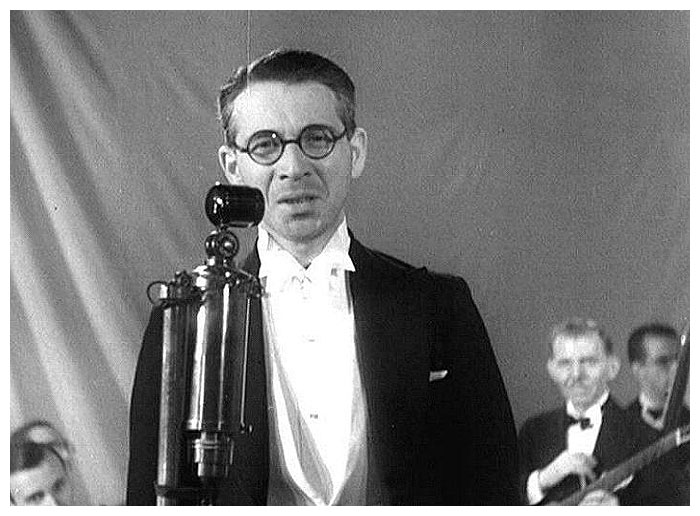
The BBC-Marconi tube condenser microphone

(Excerpted from a September 2009 eBay auction description.) This is a 1934 BBC-Marconi Technical and Research Processes Ltd. studio valve condenser microphone. This is a rare microphone and belongs in a museum. It was used by the BBC in the early days when television and radio broadcasting were in their infancy. It was designed by Mr. H. J. Round, a.k.a. Captain Henry Joseph Round, who was the chief engineer at Marconi throughout the 1920s and 30s.




Condenser microphones
A condenser microphone depends for its action on the variation of capacitance between two electrodes. A thin flexible metal diaphragm is mounted in a stretched condition in close proximity to a rigid back plate, supported by mica insulation as seen in Figure 57. The diaphragm is usually of duralumin and may be as thin as 0.001 inch. The separation between diaphragm and back plate is generally between 0.001 and 0.002 inch and the capacitance, which varies according to the separation, is approximately 300 pF for a diaphragm of 1.5-inch diameter.

Figure 57
The microphone is connected to a circuit as shown in Figure 58. Between the electrodes there is a potential difference of approximately 150 volts, applied from a battery via a resistor. The impact of a sound wave on the diaphragm causes an oscillatory variation of the capacitance; as the capacitance increases a charging current flows and a decrease of capacitance causes a discharge current. These oscillatory currents produce an alternating voltage across the resistor R proportional to the amplitude of displacement of the diaphragm. This alternating voltage is applied to the amplifier via the blocking capacitor C2, which prevents the battery voltage from reaching the amplifier.
Diaphragm displacement amplitudes due to the sound waves are so minute (about 1 × 10−11 cm) that despite the small separation of the electrodes there is no possibility of contact between them in normal operation of the microphone. To obtain a wide frequency range, the moving system of a pressure-operated condenser microphone must be substantially compliance-controlled so that the velocity is proportional to frequency, and displacement amplitude therefore independent of frequency. To meet these requirements the constants of the moving system must be such that the mechanical resonance occurs at a high frequency, preferably above the audio range.

Figure 58
Mechanical resonance at a high frequency range is made possible by a compliance reactance due to the small volume of air enclosed between the electrodes. But if the back plate has a smooth unbroken surface, the volume of the enclosed air is extremely small, making the frequency of resonance unnecessarily high and causing serious loss of sensitivity due to excessive compliance reactance in the audio range. To obtain good sensitivity, the volume of enclosed air must be increased without sacrificing the close spacing of the electrodes; this is achieved in various microphones by the introduction of grooves and cavities in the back plate, as shown in Figure 57.
The mass of the diaphragm should be small; otherwise the excessive tension necessary to obtain a high frequency of resonance will result in its fracture. If a stronger diaphragm material is employed, although the increased stiffness will contribute to the provision of a high resonant frequency, it does so only at the expense of sensitivity. The output impedance of the condenser microphone is high and capacitive, being approximately equal to that of the capacitance between diaphragm and back plate. It is therefore necessary to have the first stage of amplification located in close proximity to the microphone. The amplifier should be of small bulk to minimize diffraction effects, a good example being that of the Marconi condenser microphone seen on this page with amplifier enclosed in the lower tubular portion.
All microphone photographs are via the courtesy of Mr. Roger Beardsley, North Thoresby, Lincolnshire, U.K.
Text and illustrations are from Microphones, a book published in 1951 by the staff
of the Engineering Training Department, British Broadcasting Corporation.



The vacuum tube is an Osram A 1178. Built as a semi-experimental low-noise triode, the “A” designation meant it
had gone from being a purely experimental tube to being manufactured in small numbers for specialist purposes.


















Henry Hall and the BBC Dance Orchestra in a radio studio sequence from the 1935 GPO documentary
film called BBC—The Voice of Britain. Images and information were kindly provided by Dicky Howett.
Additional information on the GPO (General Post Office) Film Unit for 1935 is available.